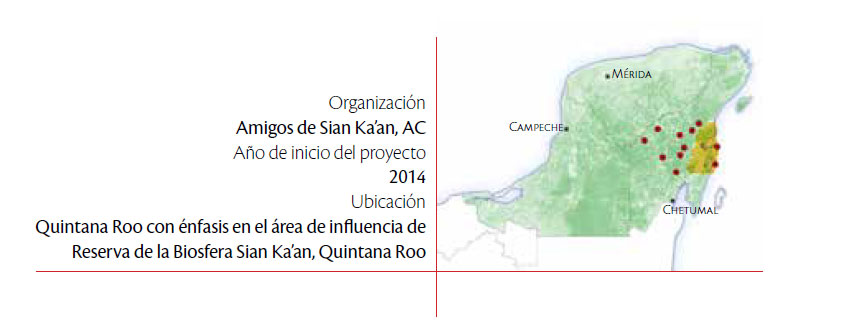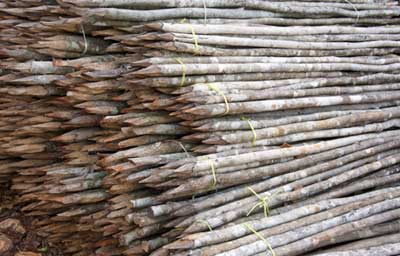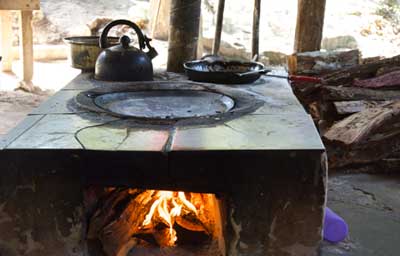Destino turístico Maya Ka´an y proyectos productivos en la Zona Maya

Amigos de Sian Ka’an ha trabajado por la conservación y el desarrollo sustentable de la Península de Yucatán, con un enfoque en Quintana Roo, desde el año 1986. Desde su fundación, Amigos de Sian Ka’an consideró que era necesario atender las necesidades de ingreso de las comunidades mayas del estado si se pretendía continuar trabajando en temas de conservación. Después de varios años de trabajo con grupos comunitarios, en 2005 se realizó un diagnóstico de los grupos productores, tipo y calidad de productos disponibles, y nivel de organización en las comunidades. Artesanías con bejucos, bordados, semillas, madera y miel eran algunos de los productos que se podían encontrar en las comunidades, pero existían dos puntos débiles: la calidad del producto y la comercialización. Con recursos de un premio otorgado por la prestigiosa Fundación Whitley Fund for Nature, Amigos de Sian Ka’an comenzó a implementar en el área de influencia de la Reserva de la Biosfera una estrategia integral de comercialización de productos comunitarios de la zona maya. En el año 2009, con apoyo del Fondo Multilateral de Inversiones del Banco Interamericano de Desarrollo (BID), el proyecto pasó a formar parte de una propuesta mayor: crear un nuevo destino que integrara a operadores ecoturísticos locales y los proyectos productivos ya iniciados, bajo un esquema regional de promoción, comercialización y desarrollo sustentable. En 2014, en el marco del Tianguis Turístico de México, el destino turístico fue presentado formalmente como Maya Ka’an ante la comunidad internacional.
En el año 2000, Amigos de Sian Ka’an incrementó sus esfuerzos para fomentar la integración de grupos de trabajo productivo en las comunidades, y se hace evidente la necesidad de avanzar en un proceso organizativo que coordine las actividades. De acuerdo con Basilio Velázquez Chi, coordinador de la oficina en Felipe Carillo Puerto de Amigos de Sian Ka’an, los artesanos iban de manera individual a los hoteles para vender su producto, lo cual evidentemente implicaba una limitación en la comercialización. Como respuesta, en el año 2005 se inicia la estrategia regional de comercialización que consta de seis etapas: diagnóstico, diseño de la estrategia, capacitación, fortalecimiento de grupos productivos, educación ambiental e intercambios de experiencias, y por último comercialización. En el año 2009, Amigos de Sian Ka’an y la organización U’yo’olché junto con los artesanos crean la cooperativa Mayak’ab (Manos Mayas), una plataforma dedicada exclusivamente a impulsar las marcas locales en el mercado. Su función es realizar catálogos de productos, ser el nexo con los clientes, responder correos y llamadas, recibir y coordinar las órdenes de compra, manejar cuentas bancarias y realizar facturaciones. Uno de los proyectos productivos más emblemáticos es Ulu’umil beh (Tierra del camino), un grupo de mujeres de la comunidad de Chumpón que se constituyó en 2006 para producir mermeladas de pitahaya, papaya y piña bajo la marca Pitahí. El grupo comenzó a reunirse en 2005 con diecisiete mujeres, pero los primeros pasos tuvieron muchos obstáculos, y el grupo se fue reduciendo hasta quedar ocho personas. Con el apoyo de Amigos de Sian Ka’an y otras organizaciones fueron comprando más equipos para la planta envasadora y extendiendo sus canales de venta que hoy ya se encuentran sólidos. Otras marcas locales integradas a la cooperativa son Ak Kuxtal, de artesanías principalmente en madera, y productos de la colmena Melitzaak.
En aquellos años, el equipo de Amigos de Sian Ka’an estaba pensando en dar un nuevo impulso a la región para que las comunidades puedan aprovechar el alto potencial ecoturístico con que cuentan. Con el apoyo de UNESCO a través de TNC, se organizó un viaje a Costa Rica con empresarios y ejidatarios de Felipe Carrillo Puerto para conocer el ejemplo de un país que logró hacer del ecoturismo un atractivo internacional y una herramienta para la conservación y el desarrollo. Esto generó el sueño de lograr ubicar a la zona de influencia de Reserva de la Biosfera Sian Ka’an en el escenario de los grandes destinos ecoturísticos a nivel internacional, y el sueño comenzó a tomar forma en 2009 con apoyo del Fondo Multilateral de Inversiones del BID. El proyecto denominado “Diversificación de la oferta turística de la Riviera Maya con base en el aprovechamiento sustentable de los atractivos de la Reserva de la Biosfera Sian Ka’an”, tuvo como uno de sus principales objetivos incorporar a las comunidades de la región en esta iniciativa.
En los años ‘90, Amigos de Sian Ka’an desarrolló un tour en lancha por los canales de Muyil para recaudar fondos. Con los años, la comunidad de Chunyaxché vio los beneficios del proyecto y solicitó permiso a las autoridades para realizar ellos mismos el paseo de manera comercial. Amigos de Sian Ka’an y otras instancias los apoyaron en capacitación, acceso a financiamiento, fortalecimiento empresarial, entre otros aspectos, y en el año 2000 es cedido el espacio ecoturístico completamente a las comunidades de Chunyaxché y Punta Allen. A partir de 2009 se logra dar un impulso a la actividad ecoturística operada por las propias comunidades dentro y fuera de la Reserva con una estrategia regional de desarrollo y turismo sustentable. Vicente Ferreyra, Director de Turismo Sustentable de Amigos de Sian Ka’an, explica que el proyecto de creación del destino turístico bajo la marca Maya Ka’an tiene un componente importante en capacitación, fortalecimiento local y de trabajo en grupo, a la vez que hace énfasis en el diseño de herramientas para la promoción y comercialización de los diecisiete centros turísticos que actualmente están apoyando. “Uno de los hitos más importantes, menciona Vicente, ha sido en 2013 la conformación del Consejo Consultivo de carácter mixto como órgano asesor y de consulta. Esto permitió acceder a nuevos incentivos financieros de organismos interesados en apoyar la propuesta, y condujo también al lanzamiento oficial de la marca Maya Ka’an en el Tianguis Turístico de 2014, la feria más importante del país en este sector, y esto marcó un segundo hito importante”.
Otro momento clave fue la vinculación con la Dirección de Turismo de la Secretaría de Medio Ambiente y Recursos Naturales (SEMARNAT), la cual financió el diagnóstico de doce empresas de la zona para certificar con la NMX-133 de ecoturismo. En 2014, siete empresas de la región obtuvieron la certificación, logrando de esta manera asegurar la sustentabilidad en sus operaciones. Por otra parte, Maya Ka’an cuenta con sus propios criterios de sustentabilidad que deben cumplir quienes se adhieran a la marca. Es un modelo de turismo innovador que busca reducir la presión de desarrollo en Sian Ka’an pero generando oportunidades de desarrollo a las comunidades mayas que la rodean basadas en la riqueza natural y cultural con que cuentan. Basilio Velázquez Chi comenta que en los inicios la idea era abrir los canales de venta de los productos y que los grupos comunitarios siguieran el proceso, pero es difícil empatar el sistema comercial a la vida comunitaria, el ritmo de vida es distinto. “Hay que tener en cuenta que muchos productores dependen de una caseta telefónica y un mensajero, o en el mejor de los casos acceden al correo electrónico una vez a la semana”. Para esto fue fundamental la creación de la comercializadora, la cual se encarga de recibir las órdenes de compra, y de estudiar cuál es la calidad del producto que el mercado requiere. “Por otra parte”, menciona José Gaspar, Gerente Comercial de la cooperativa Mayak’ab, “muchas veces el cliente necesita un producto con entrega inmediata, y al artesano le lleva tiempo lograr las piezas. La cooperativa concilia esta situación teniendo un stock para poder abastecer en tiempo y forma”. Doña Homobona Borges Dzul, Presidente del grupo de mujeres productoras Ulu’umil beh, cuenta que al principio fueron muchos trámites, tiempo, dinero y muchas reuniones sin percibir ingresos, lo que desmotivó a algunas de las mujeres que habían iniciado. Igualmente, “algunas decidimos continuar sin percibir ingresos, y hoy tenemos la recompensa de tener un trabajo en nuestra comunidad y estar con nuestras familias”. Esta iniciativa les ha dado a las mujeres mayas el valor para enfrentar cuestiones de género y libertad de disponer de su dinero. El cambio fue muy importante, cuenta Doña Homobona, “hemos aprendido mucho y nos gusta apoyar a otros grupos. Este trabajo que ya se consolidó no se va a acabar nunca; se va a acabar cuando se acabe el mundo. Nuestros nietos verán a esta empresa a través de los años”, afirma con seguridad.
“En cuanto a los proyectos de ecoturismo, dice Vicente Ferreyra, las comunidades son muy buenas dando recorridos en campo y contando experiencias locales, pero les hace falta fortalecer el aspecto comercial. El propósito es crear una red de ecoturismo que de aquí a cuatro años sea el operador del destino, es decir, así como Mayak’ab se encarga de la comercialización para los proyectos productivos, la idea es que la Red de Ecoturismo se convierta en el comercializador del destino ecoturístico Maya Ka’an, y que las comunidades se vuelvan independientes. Por ejemplo, Muyil es un caso de éxito en el que la comunidad comprobó que pueden ser económicamente sustentables y dar un servicio de calidad. Uno de los desafíos principales es hacerle saber a las comunidades que son empresarios, y necesitan tener las herramientas para hacer viables los proyectos”. Gonzalo Merediz añade que el éxito de esta red, y de Maya Ka’an en general, se basará en un organismo autónomo que gestione al destino y vigile su sustentabilidad y el buen uso de su marca. Según Damián Gómez Xool, presidente de la Red de Turismo Comunitario de la Zona Maya, lo más útil para las comunidades es haber salido del costal, y darse a conocer a nivel nacional e internacional con el lanzamiento de Maya Ka’an en el Tianguis Turístico. Hablar de ecoturismo en una comunidad es algo difícil, cuenta Damián, “es una tarea que hay que trabajar constantemente”. “Al principio la gente es muy celosa de sus tradiciones, pero hay que darle tiempo, y las comunidades comienzan a compartir sus conocimientos, cuentos, leyendas e historias. Crecer como empresario es una experiencia nueva, es hablar de ecoturismo rural sustentable”.
El éxito de las estrategias productivas y turísticas de Amigos de Sian Ka’an se basa en que no están aisladas, sino que son parte integral de una visión institucional que abarca el decreto y apoyo al manejo de áreas protegidas, el impulso a una red de reservas privadas y sociales, la creación de un mecanismo de pago por servicios ambientales, el impulso de tecnologías de tratamiento de aguas residuales, el diseño de programas de ordenamiento ecológico, la investigación científica de los recursos naturales y la educación ambiental. Desde el decreto de Sian Ka’an existen voces en la región que expresan la visión de que la reserva es un obstáculo para el desarrollo local. “Con Mayak’ab y Maya Ka’an, demostraremos que la naturaleza y cultura de la Zona Maya, y la presencia de un sitio Patrimonio de la Humanidad, son los motores de un nuevo modelo de desarrollo y conservación ambiental”, concluye Merediz. |

























